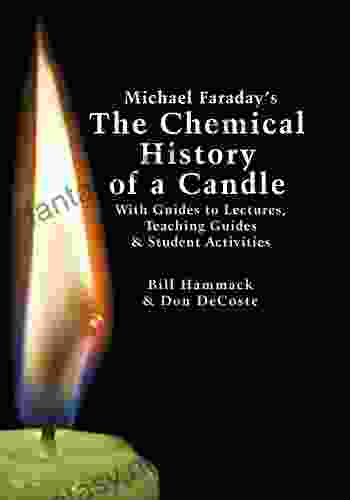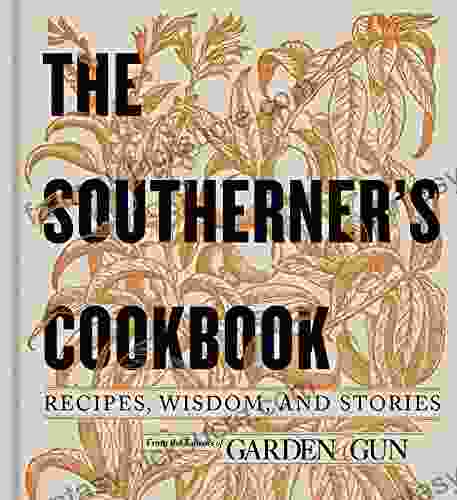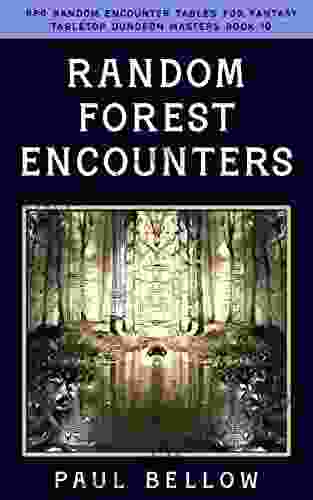Michael Faraday: The Chemical History of a Candle and Its Impact on Our Understanding of Combustion

Michael Faraday was a renowned English scientist who made significant contributions to the fields of electromagnetism and electrochemistry. Among his many notable works, his "Chemical History of a Candle" stands out as a masterpiece that captivated audiences with its engaging and informative exploration of the science behind combustion.
In 1860, Faraday delivered a series of six lectures to a young audience at the Royal Institution in London. These lectures were intended to provide a comprehensive understanding of combustion, using the humble candle as a central example. The lectures were met with great enthusiasm and were later published in book form, becoming a classic text in chemistry education.
Faraday's lectures were not merely theoretical discussions; he used a series of captivating experiments to illustrate the principles of combustion.
4.7 out of 5
| Language | : | English |
| File size | : | 1321 KB |
| Text-to-Speech | : | Enabled |
| Screen Reader | : | Supported |
| Enhanced typesetting | : | Enabled |
| Word Wise | : | Enabled |
| Print length | : | 202 pages |
| Lending | : | Enabled |
Faraday began by lighting a candle and observing its flame. He noted that the flame consisted of three distinct regions: the inner dark zone, the luminous zone, and the outer non-luminous zone. He explained that the dark zone was where the fuel (wax) vaporized and mixed with air, while the luminous zone was where the mixture burned with a bright yellow glow. The non-luminous zone was where the combustion products (carbon dioxide and water vapor) escaped into the atmosphere.
Next, Faraday demonstrated how to collect the products of combustion. He placed a cold glass jar over a burning candle, capturing the water vapor and carbon dioxide. By weighing the jar before and after the experiment, he showed that the mass of the products of combustion was greater than the mass of the original candle. This observation provided evidence that combustion involved a chemical change, rather than simply a physical one.
Faraday emphasized the crucial role of oxygen in combustion. He showed that a candle would not burn in a sealed container where oxygen was absent. He also demonstrated that the addition of pure oxygen to a burning candle intensified the flame and increased the rate of combustion.
Through his experiments and explanations, Faraday established several key findings about combustion:
- Combustion is a chemical process that involves the reaction of a fuel with oxygen.
- The products of combustion are different in composition from the original fuel.
- The amount of oxygen required for complete combustion depends on the specific fuel.
- Combustion is a self-sustaining process that releases heat and light.
"The Chemical History of a Candle" had a profound impact on the scientific understanding of combustion and its practical applications:
Faraday's lectures and book became a foundational text for chemistry education. They introduced students to the basic principles of combustion in a clear and engaging manner. The experiments described in the book became standard demonstrations in chemistry classrooms around the world.
Faraday's findings had significant implications for the development of lighting and heating technologies. By understanding the role of oxygen in combustion, inventors were able to design more efficient stoves, lamps, and other devices that burned fuels more effectively.
The principles of combustion outlined in "The Chemical History of a Candle" found practical application in industries such as manufacturing, mining, and transportation. By controlling the combustion process, engineers could optimize the performance of engines, boilers, and other machinery.
Michael Faraday's "The Chemical History of a Candle" is a timeless classic that revolutionized our understanding of combustion and its applications. Through his engaging lectures and compelling experiments, Faraday illuminated the intricate chemical processes behind the simple act of burning a candle, paving the way for countless advancements in science and technology.
4.7 out of 5
| Language | : | English |
| File size | : | 1321 KB |
| Text-to-Speech | : | Enabled |
| Screen Reader | : | Supported |
| Enhanced typesetting | : | Enabled |
| Word Wise | : | Enabled |
| Print length | : | 202 pages |
| Lending | : | Enabled |
Do you want to contribute by writing guest posts on this blog?
Please contact us and send us a resume of previous articles that you have written.
 Fiction
Fiction Non Fiction
Non Fiction Romance
Romance Mystery
Mystery Thriller
Thriller SciFi
SciFi Fantasy
Fantasy Horror
Horror Biography
Biography Selfhelp
Selfhelp Business
Business History
History Classics
Classics Poetry
Poetry Childrens
Childrens Young Adult
Young Adult Educational
Educational Cooking
Cooking Travel
Travel Lifestyle
Lifestyle Spirituality
Spirituality Health
Health Fitness
Fitness Technology
Technology Science
Science Arts
Arts Crafts
Crafts DIY
DIY Gardening
Gardening Petcare
Petcare Vernon G Zunker
Vernon G Zunker Joseph Edminister
Joseph Edminister Olivia Gordon
Olivia Gordon Leland Chant
Leland Chant George Mahood
George Mahood Farah Heron
Farah Heron John Kettle
John Kettle Paul Halpern
Paul Halpern Hugh Neill
Hugh Neill Tiffany Bergin
Tiffany Bergin Steven Hassan
Steven Hassan Steven M Levy
Steven M Levy Lee Gutkind
Lee Gutkind Chris Sajnog
Chris Sajnog Billy Griffiths
Billy Griffiths James P Allen
James P Allen Joshua Becker
Joshua Becker Carson Sievert
Carson Sievert Robert Bruce Thompson
Robert Bruce Thompson Bill Gladstone
Bill Gladstone Dinah Bucholz
Dinah Bucholz Yau Ming Ng Thompson
Yau Ming Ng Thompson Kevin C Kelleher Md Md
Kevin C Kelleher Md Md Sabaa Tahir
Sabaa Tahir Sang H Kim
Sang H Kim Paul Bellow
Paul Bellow Jennifer Kolari
Jennifer Kolari Michael J Tougias
Michael J Tougias Pat Drake
Pat Drake Bill Streever
Bill Streever Emma Griffin
Emma Griffin Bjorn Kiggen
Bjorn Kiggen Bill Karwin
Bill Karwin Shelby Mahurin
Shelby Mahurin Bob Duchesne
Bob Duchesne Christian Smith
Christian Smith Jane Nelsen
Jane Nelsen Lynette Rushton
Lynette Rushton David Nirenberg
David Nirenberg Jacques Devore
Jacques Devore Robert F Burgess
Robert F Burgess Deborah J Rumsey
Deborah J Rumsey Bryan Irwin
Bryan Irwin Bill Gutman
Bill Gutman Shantel Silbernagel
Shantel Silbernagel Sam Harris
Sam Harris Mosby
Mosby Kasun Indrasiri
Kasun Indrasiri Ellen Schuthof Lesmeister
Ellen Schuthof Lesmeister Gregg Jackson
Gregg Jackson Alan Lawrence Sitomer
Alan Lawrence Sitomer Michael Matthews
Michael Matthews Silvia Dunn
Silvia Dunn Jessica Denay
Jessica Denay Eric H Cline
Eric H Cline Ian Wilson
Ian WilsonMax Youngquist
 Claire Russell
Claire Russell Martin Davies
Martin Davies J T Williams
J T Williams Jamie Dumas
Jamie Dumas Dan Garner
Dan Garner Doug Fletcher
Doug Fletcher Fodor S Travel Guides
Fodor S Travel Guides Paris Williams
Paris Williams Melissa Layne
Melissa Layne Jim Greenwood
Jim Greenwood Wanza Leftwich
Wanza Leftwich Robert Greene
Robert Greene Tina Cassidy
Tina Cassidy J D Gauchat
J D Gauchat Deborah Blum
Deborah Blum Marilee Lebon
Marilee Lebon Nrup Parikh
Nrup Parikh Manly P Hall
Manly P Hall The Uk Mathematics Trust
The Uk Mathematics Trust Holly Donahue Singh
Holly Donahue Singh Bryan Mann
Bryan Mann Mark Booth
Mark Booth Tony Ortega
Tony Ortega Rabbi Jason Sobel
Rabbi Jason Sobel Helen Irlen
Helen Irlen Stephen L Morgan
Stephen L Morgan Styrling Strother
Styrling Strother Thad Beery
Thad Beery Marc Bona
Marc Bona Richard Holmes
Richard Holmes James Alexander Currie
James Alexander Currie Charlie Craven
Charlie Craven Michael J Epstein
Michael J Epstein Dan Hamilton
Dan Hamilton Frederica Relly
Frederica Relly Marie Viljoen
Marie Viljoen Elsevier
Elsevier Neil D Jespersen
Neil D Jespersen Tim Weston
Tim Weston H P Lovecraft
H P Lovecraft Hayley Mitchell Haugen
Hayley Mitchell Haugen Dawn Hadley
Dawn Hadley Valeria Ray
Valeria Ray Sandra Davidson
Sandra Davidson Daniel J Velleman
Daniel J Velleman Mark Vanhoenacker
Mark VanhoenackerR E S
 Pete Spencer
Pete Spencer Steve Biddulph
Steve Biddulph T Whitmore
T Whitmore Betsy Herman
Betsy Herman Bill Patton
Bill Patton Mercedes Lackey
Mercedes Lackey Joan Roughgarden
Joan Roughgarden Morgan Oostra
Morgan Oostra Marty Gitlin
Marty Gitlin Mike Gibson
Mike Gibson Joann Cianciulli
Joann Cianciulli Rachna Chhachhi
Rachna Chhachhi James W Finegan
James W Finegan Heather Long
Heather Long Joe Byers
Joe Byers Al Walsh
Al Walsh Rick Reilly
Rick Reilly Sanford Holst
Sanford Holst Sandra Berenbaum
Sandra Berenbaum Edwin H Friedman
Edwin H Friedman Editors Of Sports Illustrated
Editors Of Sports Illustrated Dan Yaccarino
Dan Yaccarino Leah Day
Leah Day Editors Of Garden And Gun
Editors Of Garden And Gun Dr Nancy L Nolan
Dr Nancy L Nolan Charles Goodwill
Charles Goodwill Laurence Price
Laurence Price Jane Bottomley
Jane Bottomley Phil Robertson
Phil Robertson Clifford A Pickover
Clifford A Pickover Meagan Trayler
Meagan Trayler Douglas W Ota
Douglas W Ota Jitendra Chouksey
Jitendra Chouksey Issai Chozanshi
Issai Chozanshi Craig Chappelow
Craig Chappelow Peter Jackson
Peter Jackson Michael Volkmar
Michael Volkmar Sheridan Anderson
Sheridan Anderson Fred H Croom
Fred H Croom Daniele Benedettelli
Daniele Benedettelli T Edward Nickens
T Edward Nickens Terry Pratchett
Terry Pratchett David Benjamin
David Benjamin Davi Kopenawa
Davi Kopenawa Susan M Orsillo
Susan M Orsillo Scott Wilson
Scott Wilson Mark Solms
Mark Solms Mark Lehner
Mark Lehner James R Payne
James R Payne Dan Murphy
Dan Murphy Sara Low
Sara Low Rachael Scdoris
Rachael Scdoris Tom Humphrey
Tom Humphrey Billy Martin
Billy Martin Dean Keith Simonton
Dean Keith Simonton Rebekah Nathan
Rebekah Nathan David Joyce
David Joyce Simon Pridmore
Simon Pridmore Supersummary
Supersummary Jon Loeliger
Jon Loeliger Bill Moeller
Bill Moeller Henry Nicholls
Henry Nicholls Elliot Kay
Elliot Kay Joshua Foer
Joshua Foer Bill Bennett
Bill Bennett Karen Armstrong
Karen Armstrong Gary Dean Quesenberry
Gary Dean Quesenberry Ta Nehisi Coates
Ta Nehisi Coates Karen Palacios Jansen
Karen Palacios Jansen Linda Bauer
Linda Bauer Herschel Knapp
Herschel Knapp Dylan Tomine
Dylan Tomine Ezekiel Eversand
Ezekiel Eversand Jared Derksen
Jared Derksen Clement Salvadori
Clement Salvadori Jen Castleberry
Jen Castleberry Conway X Bowman
Conway X Bowman Ryan Johnston
Ryan Johnston Karyn D Hall
Karyn D Hall Jacques Steinberg
Jacques Steinberg Sue L Hamilton
Sue L Hamilton Elizabeth Winthrop
Elizabeth Winthrop Carolyn Schulz
Carolyn Schulz Jeremy Paxman
Jeremy Paxman Nicole R Taylor
Nicole R Taylor Margo Armstrong
Margo Armstrong P J E Peebles
P J E Peebles Steve Schwartz
Steve Schwartz Ginger Sinsabaugh
Ginger Sinsabaugh Gavin Weightman
Gavin Weightman Kiera Cass
Kiera Cass Bill Boyum
Bill Boyum Frank Giampaolo
Frank Giampaolo Jeff Wheeler
Jeff Wheeler Greg Witt
Greg Witt Chris Sims
Chris Sims Dr Julissa Hernandez Nd Cnhp
Dr Julissa Hernandez Nd Cnhp John Mccollister
John Mccollister Helen Clarke
Helen Clarke Ingrid Chalufour
Ingrid Chalufour Jessica Taylor
Jessica Taylor Ted Kaczynski
Ted Kaczynski Marsha Vanwynsberghe
Marsha Vanwynsberghe Suzannah Rowntree
Suzannah Rowntree Kenny Dill
Kenny Dill R E Skibiski
R E Skibiski Robert Axelrod
Robert Axelrod Bill Nowlin
Bill Nowlin Michael D Alessio
Michael D Alessio Charles A Rhodus
Charles A Rhodus Richard W Fisher
Richard W Fisher Marcus Brotherton
Marcus Brotherton Lisa Dorfman
Lisa Dorfman Richard Rohr
Richard Rohr Evan Purcell
Evan Purcell Simon Baron Cohen
Simon Baron Cohen Isabel Fonseca
Isabel Fonseca Joseph Campbell
Joseph Campbell Irene Mceachen
Irene Mceachen Sarah Zettel
Sarah Zettel Hilary Nangle
Hilary Nangle Blake Sebring
Blake Sebring Yossi Ghinsberg
Yossi Ghinsberg Jelena Bogdanovic
Jelena Bogdanovic Stacie Mahoe
Stacie Mahoe Michael Sullivan
Michael Sullivan Diana Wynne Jones
Diana Wynne Jones Jennifer Shannon
Jennifer Shannon Zach Schonbrun
Zach Schonbrun Justin Lichter
Justin Lichter Michael Lempert
Michael Lempert Rough Guides
Rough Guides Robert P Beebe
Robert P Beebe Diondre Mompoint
Diondre Mompoint Adiba Jaigirdar
Adiba Jaigirdar Curt Sampson
Curt Sampson David E Stuart
David E Stuart Gary Player
Gary Player General
General Frank S Ring
Frank S Ring Elizabeth Thompson
Elizabeth Thompson Thomas Cleary
Thomas Cleary G William Barnard
G William Barnard Sheila Mackechnie Murtha
Sheila Mackechnie Murtha Paula Yoo
Paula Yoo Megan Don
Megan Don Joy Hakim
Joy Hakim Brandon Sanderson
Brandon Sanderson Rachel Burgess
Rachel Burgess Bob Duff
Bob Duff Kevin Marx
Kevin Marx John Muir Laws
John Muir Laws Jackie Bolen
Jackie Bolen David Price
David Price Scarlett Curtis
Scarlett Curtis Kindle Edition
Kindle Edition Jamie Foxx
Jamie Foxx Holly Jackson
Holly Jackson Harlan Coben
Harlan Coben Marion Zimmer Bradley
Marion Zimmer Bradley Beck Weathers
Beck Weathers Jon M Sweeney
Jon M Sweeney Ernest Raymond
Ernest Raymond Bob Glover
Bob Glover Michael W Eysenck
Michael W Eysenck Oscar Nilson
Oscar Nilson Virginia Smith Harvey
Virginia Smith Harvey Donncha Hanna
Donncha Hanna Matt Parker
Matt Parker Ian Tuhovsky
Ian Tuhovsky Janice Selekman
Janice Selekman Pedro Urvi
Pedro Urvi Holger Schutkowski
Holger Schutkowski Sharmila Desai
Sharmila Desai Felicity Aston
Felicity Aston Ron Elbe
Ron Elbe Melissa Abramovitz
Melissa Abramovitz J Robert King
J Robert King Kate Darling
Kate Darling Vanessa Lapointe
Vanessa Lapointe Maggi Savin Baden
Maggi Savin Baden George C Thomas
George C Thomas Jakub Marian
Jakub Marian Kasey Edwards
Kasey Edwards Phoebe Bailey
Phoebe Bailey Peter Julius Sloan
Peter Julius Sloan Jonathan Crichton
Jonathan Crichton Tiffany Loggins Psyd
Tiffany Loggins Psyd Paul Levy
Paul Levy Tara Bianca
Tara Bianca Gwendoline Smith
Gwendoline Smith Yakima Canutt
Yakima Canutt Jarrett Dapier
Jarrett Dapier Bode Miller
Bode Miller Susan Shelby Torrance
Susan Shelby Torrance Rod Powers
Rod Powers Wendy Hinman
Wendy Hinman Blaine Bartel
Blaine Bartel Jedd K Parkinson
Jedd K Parkinson Emma Cannon
Emma Cannon Russ Harris
Russ Harris Tom Dodd
Tom Dodd Dina Nayeri
Dina Nayeri Gail Fay
Gail Fay Charles Simpson
Charles Simpson Mike Veny
Mike Veny Sophia Freeman
Sophia Freeman Mike Westerfield
Mike Westerfield Mary Griffith
Mary Griffith Krista Tippett
Krista Tippett Peter Aitken
Peter Aitken Izzy Judd
Izzy Judd Colin Thubron
Colin Thubron Katie Singer
Katie Singer Colleen Graves
Colleen Graves David E Johnson
David E Johnson Zane Grey
Zane Grey Erin Mckittrick
Erin Mckittrick Kat Kruger
Kat Kruger Mark Young
Mark Young John H Holland
John H Holland Rick Steves
Rick Steves Chris Napier
Chris Napier Dick Edie
Dick Edie D C Haenlien
D C Haenlien Ramona Finn
Ramona Finn Jamie Aten
Jamie Aten Claudia Mazzucco
Claudia Mazzucco Henry Charles Lea
Henry Charles Lea Manoj Sharma
Manoj Sharma Kevin Sverduk
Kevin Sverduk John C Norcross
John C Norcross Bill Miller
Bill Miller Chris Ferrie
Chris Ferrie William F Keegan
William F Keegan Michael Hartman
Michael Hartman Zigzag English
Zigzag English Doug Scott
Doug Scott Gary Kamiya
Gary Kamiya Dan Blanchard
Dan Blanchard James Dashner
James Dashner Jackie Brown
Jackie Brown Tony Guerra
Tony Guerra Kate Marchant
Kate Marchant Cheryl Marlene
Cheryl Marlene Laura Nowlin
Laura Nowlin Cherie Dimaline
Cherie Dimaline Christopher Banecks
Christopher Banecks Anya Kamenetz
Anya Kamenetz Ken Venturi
Ken Venturi Victoria Johnson
Victoria Johnson Special Tactics
Special Tactics Larry Baush
Larry Baush Sue Enquist
Sue Enquist Erin Beaty
Erin Beaty Mindy Mcginnis
Mindy Mcginnis Charlotte E English
Charlotte E English Matt Doeden
Matt Doeden Nancy Romita
Nancy Romita Jacqueline B Persons
Jacqueline B Persons Pat Cohen
Pat Cohen Callum Roberts
Callum Roberts S W Wilcox
S W Wilcox Marisa Imon
Marisa Imon Luciano Floridi
Luciano Floridi John Mccannon
John Mccannon Elizabeth A Stanley
Elizabeth A Stanley Zoe Hana Mikuta
Zoe Hana Mikuta Chris Fischer
Chris Fischer Stephanie Manley
Stephanie Manley Shannon Sovndal
Shannon Sovndal Bill Hammack
Bill Hammack Michael Tlanusta Garrett
Michael Tlanusta Garrett Carlos Castaneda
Carlos Castaneda Thomas Bailey
Thomas Bailey Patrick Mcginty
Patrick Mcginty Megan Mcgrory Massaro
Megan Mcgrory Massaro Rocky Mcelveen
Rocky Mcelveen Eric A Weiss Md
Eric A Weiss Md J Douglas Faires
J Douglas Faires Fiona Danks
Fiona Danks Zavonda Vinson Parrish
Zavonda Vinson Parrish Herbert Dorsey
Herbert Dorsey Bill Schneider
Bill Schneider Gianna Sobol
Gianna Sobol Stephen Arterburn
Stephen Arterburn Vukota Boljanovic
Vukota Boljanovic Richard B Pelzer
Richard B Pelzer Kristin N Spencer
Kristin N Spencer Martyn Denscombe
Martyn Denscombe C D Holmes Miller
C D Holmes Miller Bharath Ramsundar
Bharath Ramsundar Enzo Tonti
Enzo Tonti Matthew Bowling
Matthew Bowling Gary Nicol
Gary Nicol Rob Steger
Rob Steger Ofer Gal
Ofer Gal Carlos Torres
Carlos Torres James Patterson
James Patterson Jojo Siwa
Jojo Siwa Henry M Cowles
Henry M Cowles Simon Buxton
Simon Buxton Sara Dyer
Sara Dyer Zecharia Sitchin
Zecharia Sitchin Paul Brummell
Paul Brummell Jake Jacobson
Jake Jacobson Lucas Bessire
Lucas Bessire Robert A Pelcovits
Robert A Pelcovits Sandi Mann
Sandi Mann John Brierley
John Brierley Jessica Wiebe
Jessica Wiebe Carl B Tolman
Carl B Tolman Louis Sachar
Louis Sachar Jeffrey Lindsey
Jeffrey Lindsey Aylette Jenness
Aylette Jenness Kristopher Martel
Kristopher Martel Richard Post
Richard Post Linda D Dahl
Linda D Dahl Freddie Fernandez
Freddie Fernandez Joie Jager Hyman
Joie Jager Hyman Curvebreakers
Curvebreakers Paul Francis
Paul Francis Brian Crist
Brian Crist Cj Andersen
Cj Andersen Max Lugavere
Max Lugavere Dawn Huebner
Dawn Huebner Charles Duhigg
Charles Duhigg Sharon Bergen
Sharon Bergen Brienne Murk
Brienne Murk Bex Gunn
Bex Gunn David Halberstam
David Halberstam Ross Edgley
Ross Edgley Marie Max House
Marie Max House Rupert Spira
Rupert Spira Rob Casey
Rob Casey Shawn Levy
Shawn Levy Elizabeth King
Elizabeth King Erin Mcrae
Erin Mcrae Bev Pettersen
Bev Pettersen Geraldine Van Bueren
Geraldine Van Bueren Dave Pine
Dave Pine Laurie Rubin
Laurie Rubin Phil Genova
Phil Genova Genius Reads
Genius Reads Dashka Slater
Dashka Slater Wendy Doniger
Wendy Doniger Ross Bonander
Ross Bonander Max Help Workbooks
Max Help Workbooks Stephan A Hoeller
Stephan A Hoeller Brad States
Brad States Andrea Cremer
Andrea Cremer Kent Hrbek
Kent Hrbek Stanislas Dehaene
Stanislas Dehaene Robert Byron
Robert Byron
Light bulbAdvertise smarter! Our strategic ad space ensures maximum exposure. Reserve your spot today!

 Nathaniel PowellLSAT Logic Games Diagrams: A Comprehensive Guide to Understanding and Solving...
Nathaniel PowellLSAT Logic Games Diagrams: A Comprehensive Guide to Understanding and Solving... Charles ReedFollow ·19.1k
Charles ReedFollow ·19.1k Fabian MitchellFollow ·9.9k
Fabian MitchellFollow ·9.9k Aleksandr PushkinFollow ·18.4k
Aleksandr PushkinFollow ·18.4k Barry BryantFollow ·14.2k
Barry BryantFollow ·14.2k Michael CrichtonFollow ·5.9k
Michael CrichtonFollow ·5.9k Cole PowellFollow ·5.9k
Cole PowellFollow ·5.9k Leo MitchellFollow ·7.7k
Leo MitchellFollow ·7.7k Francisco CoxFollow ·3.4k
Francisco CoxFollow ·3.4k

 Sammy Powell
Sammy PowellBalancing Your Hormones Naturally: Regaining Fertility...
Hormones play a vital role in our...

 Kendall Ward
Kendall WardThe Other Baby Book: A Comprehensive Guide to Baby's...
The Other Baby...

 Kenneth Parker
Kenneth ParkerA Comprehensive Guide to Yoga Sadhana for Mothers:...
Motherhood is a...

 Neil Parker
Neil ParkerInside the Secret Space Programs
An Exposé...
4.7 out of 5
| Language | : | English |
| File size | : | 1321 KB |
| Text-to-Speech | : | Enabled |
| Screen Reader | : | Supported |
| Enhanced typesetting | : | Enabled |
| Word Wise | : | Enabled |
| Print length | : | 202 pages |
| Lending | : | Enabled |














